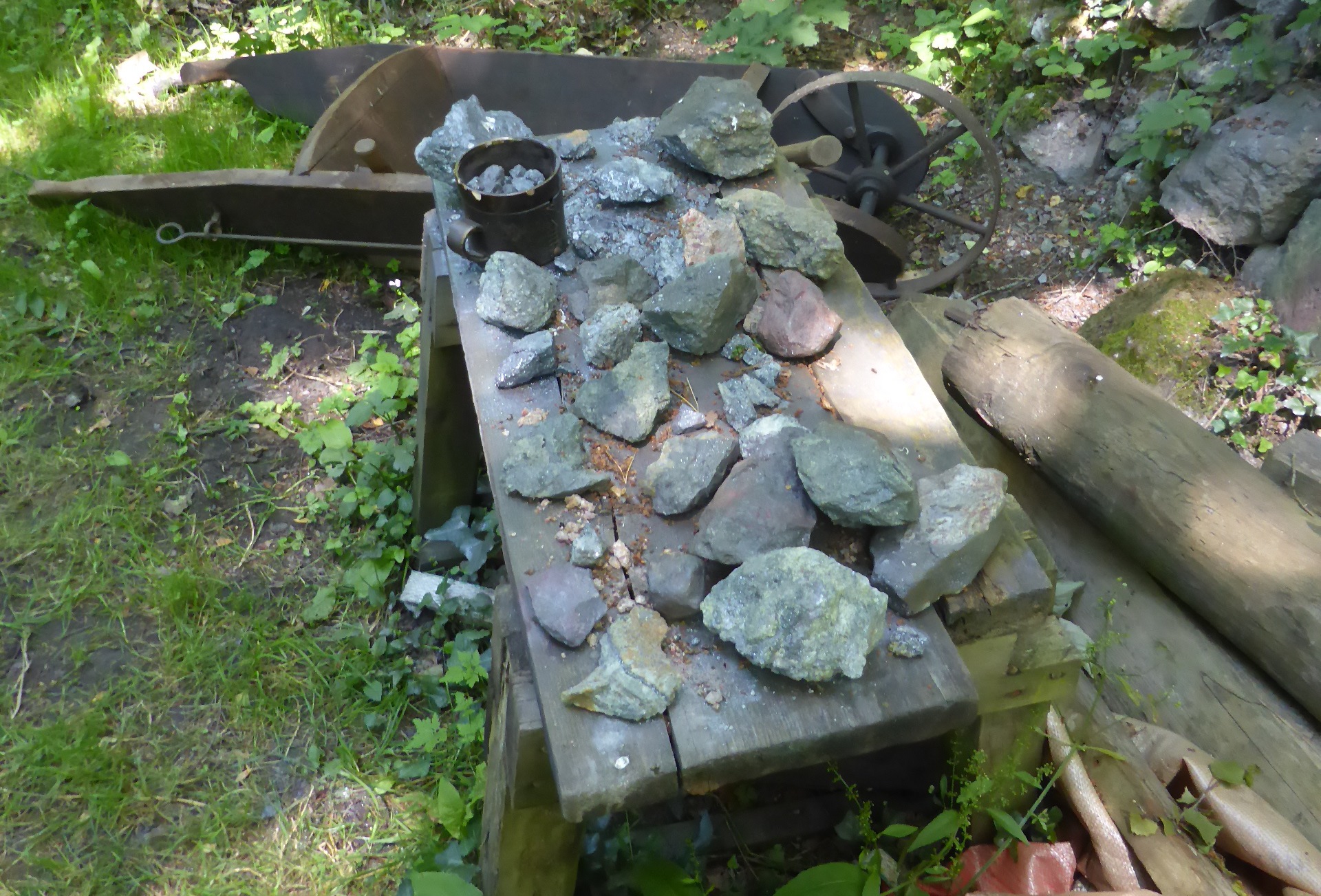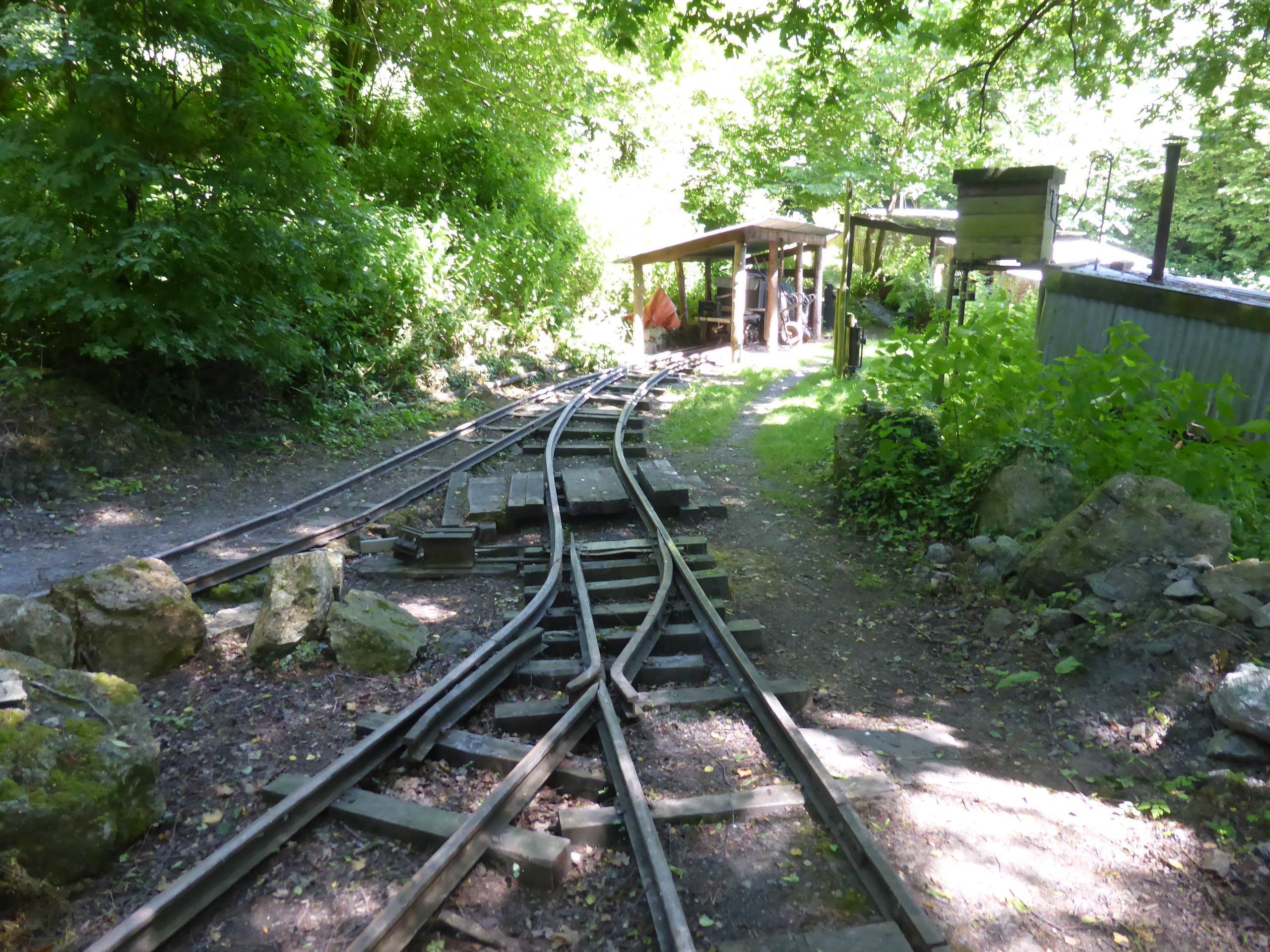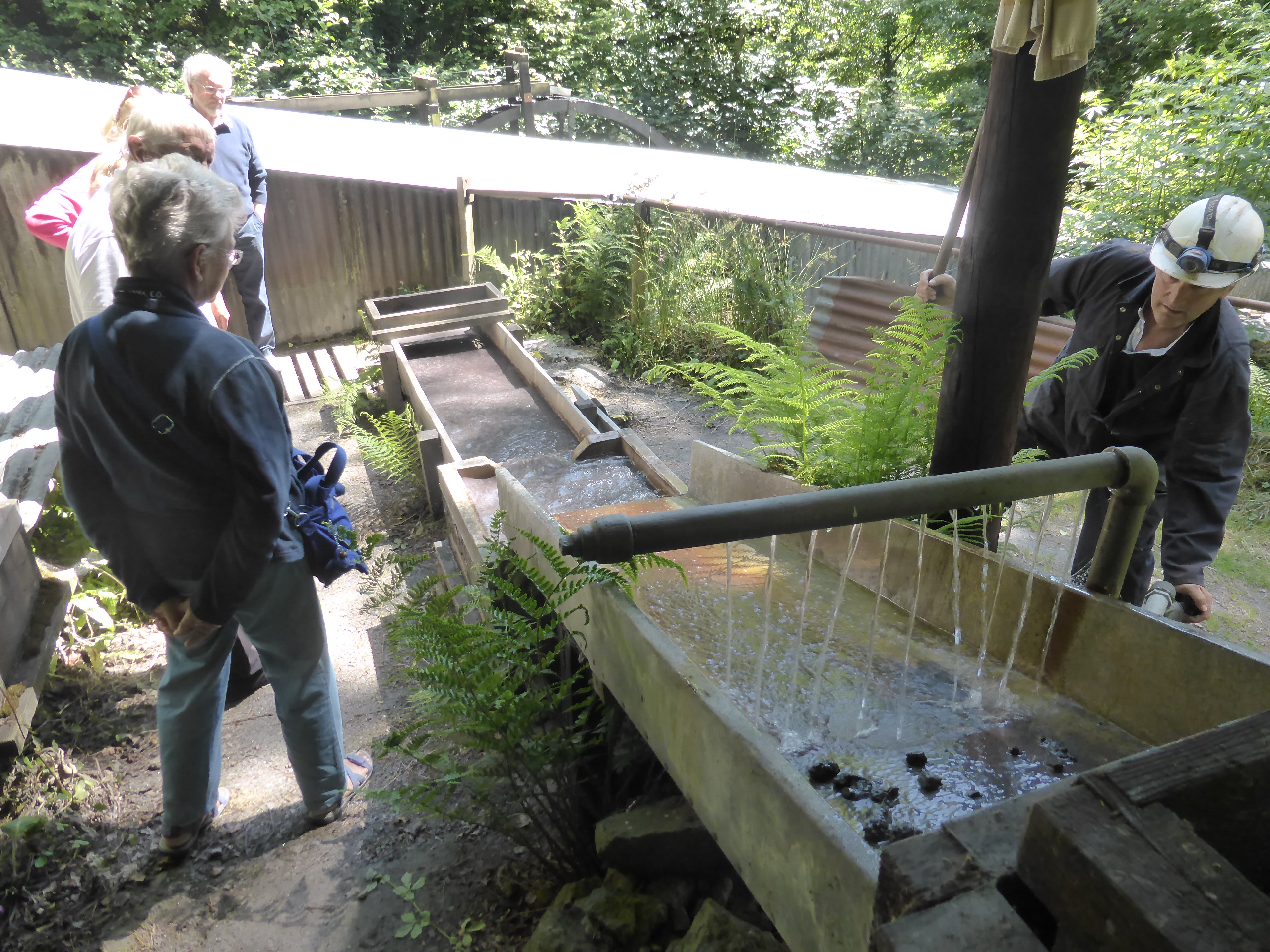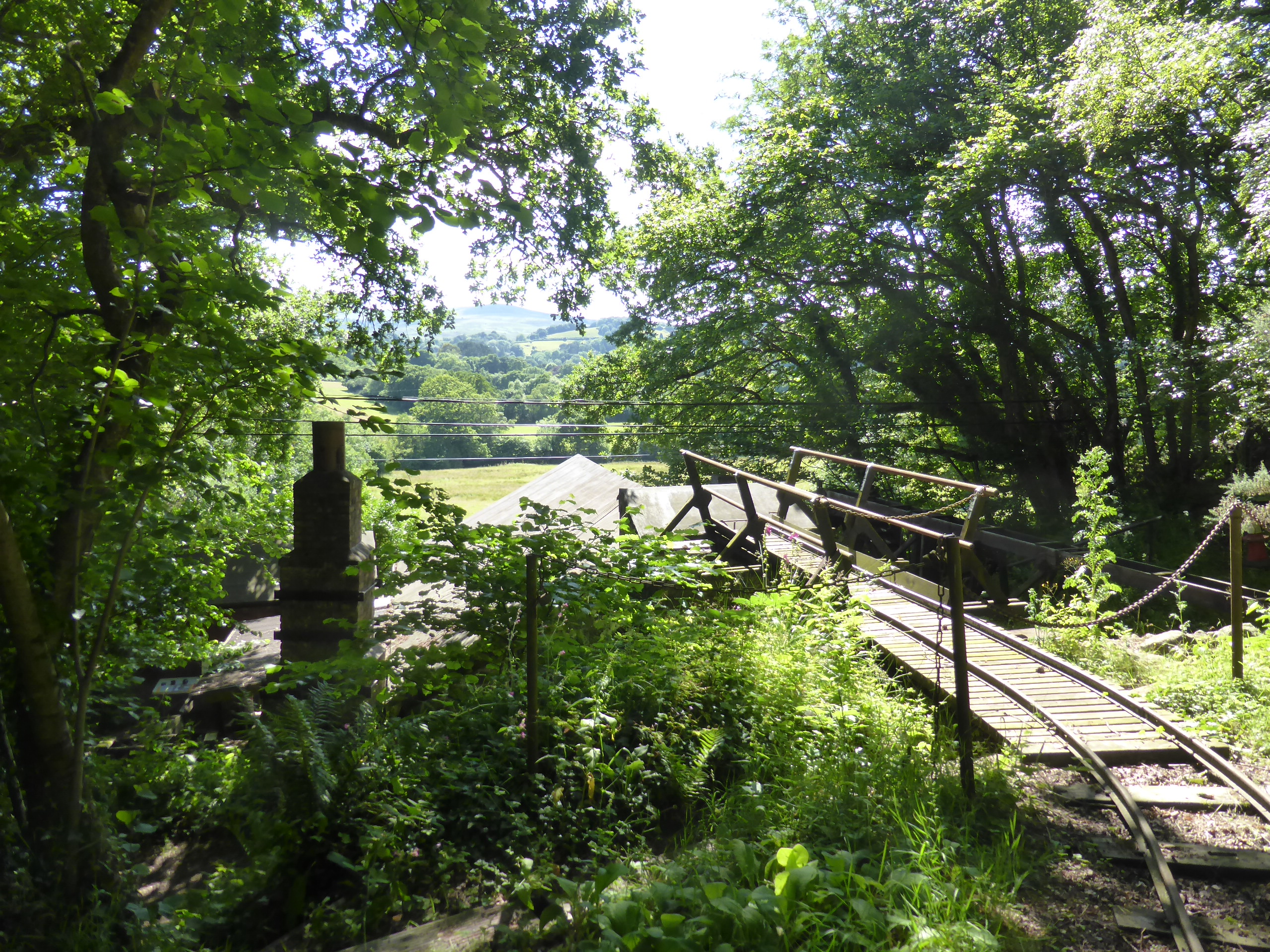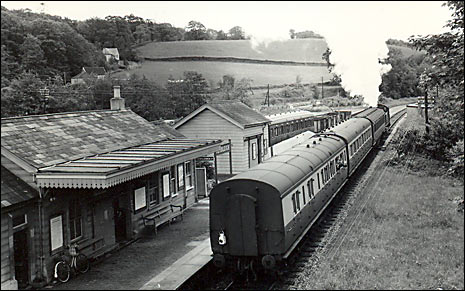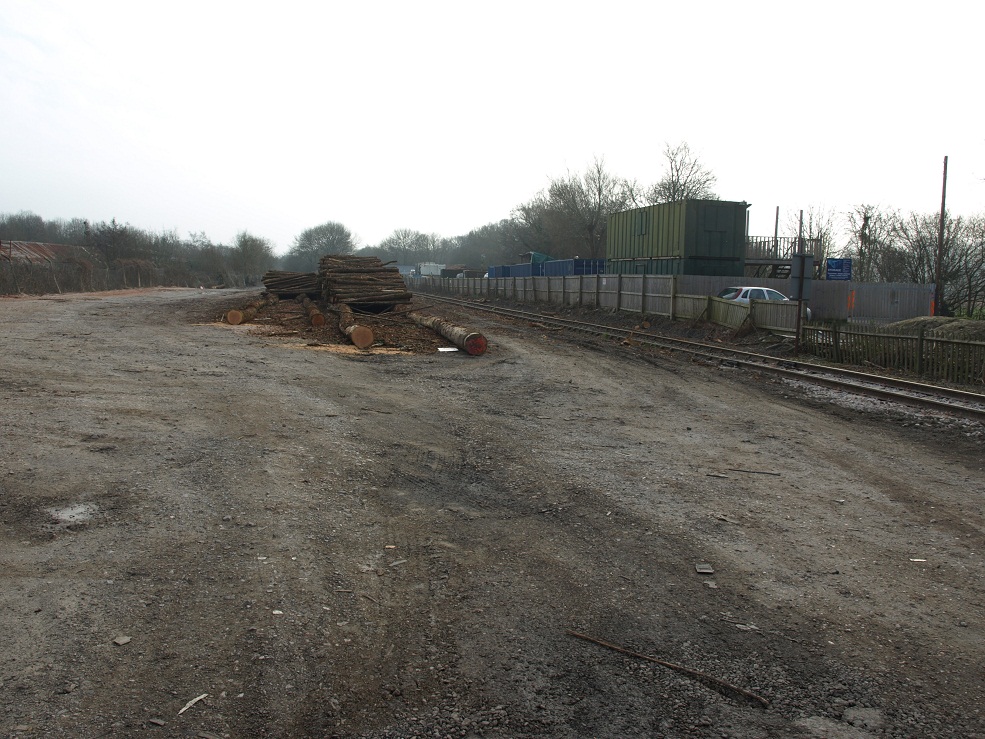The Teign Valley Railway (TVR) is one of the many small sleepy branch lines that disappeared during the 1950s and 1960s, and which can generate fond memories of ‘the golden age of steam’. They also perhaps remind older readers of former, less hectic lifestyles, but in the case of the TVR its working life coincided with a period when mining and quarrying operations were prominent in the valley, with their attendant noise, dust and water pollution – the section of the valley along which the railway ran is much quieter nowadays.
The TVR had a long gestation period; each new rail route required a special Act of Parliament, and the one covering the TVR was passed in 1863. However, after that it took a long time to line up the necessary finance, and it didn’t get built until 1882. The line branched off from the Moretonhampstead and South Devon Railway’s station at Heathfield, about 6km north of the main Newton Abbot station.
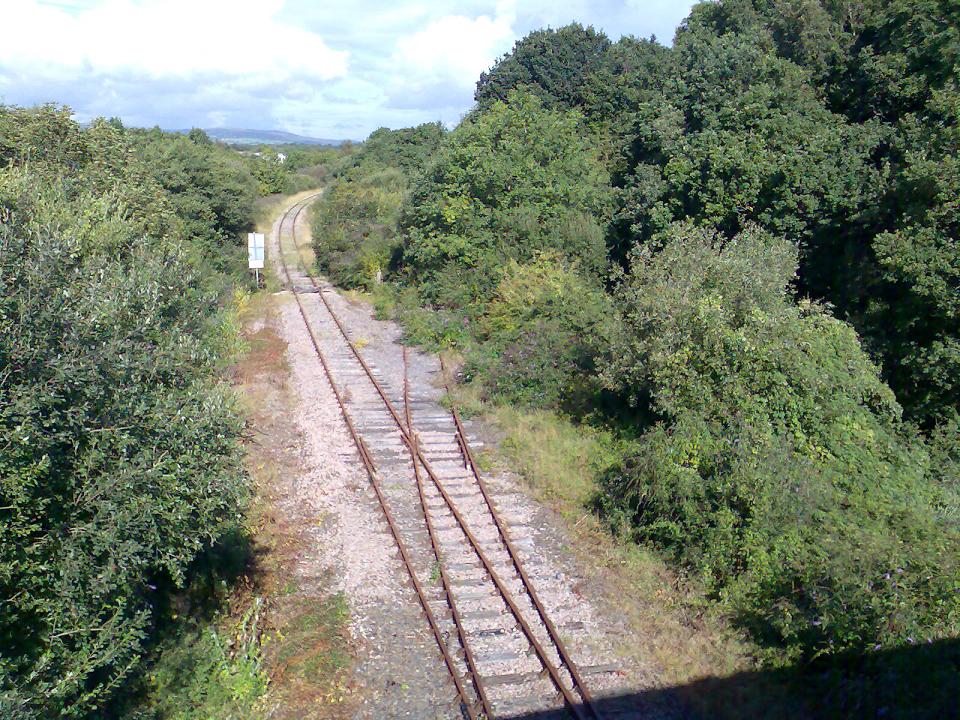 The Newton Abbot to Heathfield railway line, from the Newton Road bridge. (September 2009). The branch off to the right was presumably originally built to serve the East Golds clay works.
The Newton Abbot to Heathfield railway line, from the Newton Road bridge. (September 2009). The branch off to the right was presumably originally built to serve the East Golds clay works.
When first opened, the TVR terminated for freight at Teign House Siding, named for the nearby public house, and just short of the later site of Christow station. The passenger terminus was at Ashton station. In the section on the Teign in The Rivers of Devon from Source to Sea published in 1893, the author John Lloyd Warden Page describes it as ‘that ridiculous little branch line which has been said – and truly – to begin on a heath and end in a field’.
The Teign valley between Dunsford and Chudleigh Knighton was not (and is still not) heavily populated. The only place of any size was Chudleigh and, apart from Lower Ashton and Chudleigh Knighton, all the settlements were on valley slopes some way away from potential station sites. So rather than passenger traffic, the real inspiration for the railway was mining, which was booming in the 1860s when the first plans were drawn up. Mining in the Teign valley had started in the 1810s, but was not conducted on a significant scale until the 1850s. The main product was lead, but silver, zinc, iron, barytes and manganese were also mined. The Teign was not navigable above Newton Abbot so the ores had to be transported by road in horse drawn wagons to the Stover Canal or to Newton Abbot for loading onto river barges for the journey to the seaport at Teignmouth. Coal for the mine engines had to come on the same route in reverse. This transport was a significant additional cost, which made the Teign valley mines uncompetitive. Rival mines elsewhere had rail links, but until the 1860s the output was insufficient to justify the railway being built, although this was in the nature of a vicious circle, which the local mine owners became determined to tackle with a railway running along the valley linked to the main line.
But unfortunately the boom in the most profitable product, lead, was short lived. The Teign valley mines were soon worked out, and then in 1878 the market price collapsed as large supplies of lead became available from overseas at prices British mines could not match. As a consequence, the last lead mine in the valley closed in 1880, two years before the railway opened. To make matters worse, for the first ten years the main Great Western Railway (GWR) line and the Moretonhampstead branch ran on broad gauge rails, as initially favoured by Brunel. But by the time the TVR was built the whole country was committed to standard gauge, and so it was built with standard gauge rails. This meant that for onward travel freight had to be transferred from standard to broad gauge wagons at Heathfield, involving additional cost. This was resolved in 1892 when the final section of the West Country main line, and the Moretonhampstead branch, were converted to standard gauge.
Mining had brought an increased population into the area and, although passenger traffic was never expected to pay for the railway, its potential was reduced further as the mines closed and workers and their families moved away. The 1901 population of the valley was about 30% down compared to 1861 – in contrast the national population increased by over 40% over this period.
Consequently during its first twenty years the TVR was little used. For passengers there was only one locomotive and train set serving the single track line, and its speed was limited to 12mph. This seems very slow , but of course if you wanted to travel between places along the valley at this time the alternative would have been riding on or behind a horse, or walking. (Or from around the mid-1890s, cycling, when the first bicycles that resemble modern machines became available, although even then they were still too expensive for ordinary working people.)
It was realised that a line terminating at Teign House/ Ashton wasn’t commercially viable, so as soon as the TVR was in operation there was interest in extending it to Exeter. After further lengthy negotiations, this was achieved in 1903 with a line that ran via Ide to join the main line just south of St Thomas station, increasing the total length of the railway from eight to just under 16 miles.
In the 1880s there was also a plan to have a 9 mile branch off the TVR from a junction at Leigh Cross, to Chagford. The proposed route ran next to the river along the bottom of the Teign Gorge, with an intermediate station at Fingle Bridge and terminating near Rushford Bridge, just to the east of Chagford. But there were no mines along this route and the potential traffic to and from Chagford was insufficient, and it was never built.
When the mixed gauge problem was solved and unit transport costs reduced accordingly, it became economic to quarry for roadstone. The first such quarry opened at Crockham near Trusham station in 1895, with others getting underway during the next decade. The link to Exeter encouraged further quarrying developments as transport costs to Exeter and beyond were reduced, and increases in motor car numbers generated a demand for roadstone nationally. Roadstone production in the valley peaked at 200,000 tons in 1913-4, almost all sent by rail from Trusham and Christow, and this trade dominated traffic on the line. Some quarries not as productive after the War, as by then the stone easiest to reach had already been extracted. The Scatter Rock quarry at Christow Common, which opened in 1914, continued to flourish during the 1920s, and didn’t finally close until 1950. The other roadstone quarries closed during the 1930s.
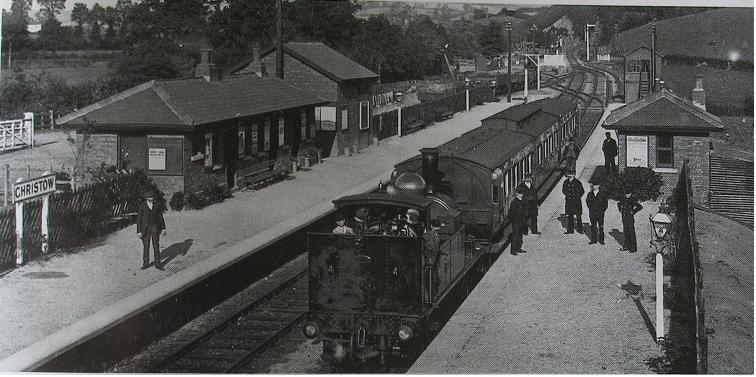 Christow station in 1905. Most of the people on the platform appear to be railway staff rather than real passengers
Christow station in 1905. Most of the people on the platform appear to be railway staff rather than real passengers
… and below in 1921 when the Scatter Rock roadstone quarry was producing freight traffic, and apparently covering everything with a light coloured dust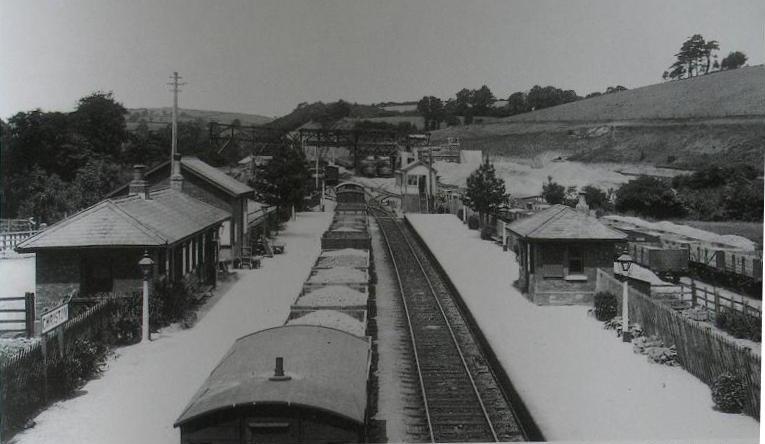
One small mining operation that can still be seen is the Kelly Mine near Lustleigh. It was most active during the first half of the 20th century, and worked deposits of micaceous iron oxide, also known as ‘shiny ore’.
Some examples of unprocessed micaceous iron oxide ore (July 2016)
It was never a big business, and probably no more than ten people worked here at any one time. Production of the finished product – a black dust with shiny flakes in it, peaked at 202 tons in 1907. This was marketed as ‘’Devonshire Sand’ or ‘Pounce’ and was used to absorb the ink on hand written documents prior to the invention of blotting paper. It was also used as a pottery glaze, as a substitute for graphite, and on its own or mixed with graphite it was ‘black lead’ for protecting stoves. But ultimately its main value was as the basis of an anti-corrosion paint, which was in great demand for the protection of metal structures of all kinds. The mine closed in 1952 after an underground collapse. Due to a legal dispute all the equipment at the site was left untouched, rather than the usual practice of selling it for scrap or moving it for use in another mine, and subsequent owners have encouraged its preservation. So Kelly now has a unique collection of mining machinery on the site where it was actually used.
Part of the small gauge track used to move material around the mine site on trucks.
The enterprise is run by members of the Kelly Mine Preservation Society, who have undertaken much restoration work over the last 30 years. Guided tours take visitors round the site, describing the whole process from mining the ore to the dispatch of the final product. Some of the equipment is in working order: the ore washing strips, and jigging and stamping equipment, and other machinery in the mill.
A demonstration of ore washing.
The settling tanks, waterwheels and the mine tramway, with its wagons and haulage winch, are not in use, but help to visualise what it was like in its heyday. It was clear that many of the tasks involved in extracting the ‘shiny ore’ from the mined material were very physical, repetitive and dirty, and apparently were often undertaken by teenage boys straight from school, until they could find something better. When the mine was in operation the site was largely devoid of trees and sheep grazed in the fields around. Sixty years on and the mine site is now in an attractive, rather overgrown, woodland setting with high trees all round.
The woodland setting of the mine buildings (July 2016).
Back at the railway ….. passenger traffic picked up during the 1920s and new station halts were built at Chudleigh Knighton and Dunsford but it declined again in the 1930s as car ownership increased, and there was competition from bus services. In the 1930s there were so few passengers that the guards knew all the regulars and often held trains if one was late arriving. Because of the small numbers, by 1930 the GWR (who had bought the TVR from the original owners in 1923) were thinking of closing it for passengers. But in that year a breach of the sea wall at Dawlish on the main line made them think again as the TVR could be used as part of an alternative route to Plymouth and Cornwall if the main line was out of action.
The use of the TVR as a diversionary route was first discussed in 1916, and this led to the replacement of some of the original timber bridges with metal ones in the early 1920s, to enable heavier trains to use the line. Later other bridges with simple girder supports were also rebuilt. (The Crockham bridge was rebuilt in 1933) During the 1920s and 1930s there were several occasions when main line trains were diverted along the TVR, because of damage to the stretch of line running along the coast.
 A modern example of main line track closure because of storm damage at Dawlish (October 2004). On this occasion many of the protective metal plates holding the ballast in place under the track on the seaward side, were ripped up by the force of the waves. Some of the displaced plates can be seen in the middle distance stacked up against the railing. (There was much greater damage to the track more recently, in February 2014, when a section to the north of the station was left hanging in mid-air, and the line was closed for two months for major repairs.)
A modern example of main line track closure because of storm damage at Dawlish (October 2004). On this occasion many of the protective metal plates holding the ballast in place under the track on the seaward side, were ripped up by the force of the waves. Some of the displaced plates can be seen in the middle distance stacked up against the railing. (There was much greater damage to the track more recently, in February 2014, when a section to the north of the station was left hanging in mid-air, and the line was closed for two months for major repairs.)
During World War II there was increased concern that the coastal line – the supply route to the important naval base at Plymouth – would be attacked, and so the TVR was kept open for traffic 24/7 from 1941 to the end of the war. However in the event there were no problems with the main line throughout the war, and it was never needed as a diversionary route.
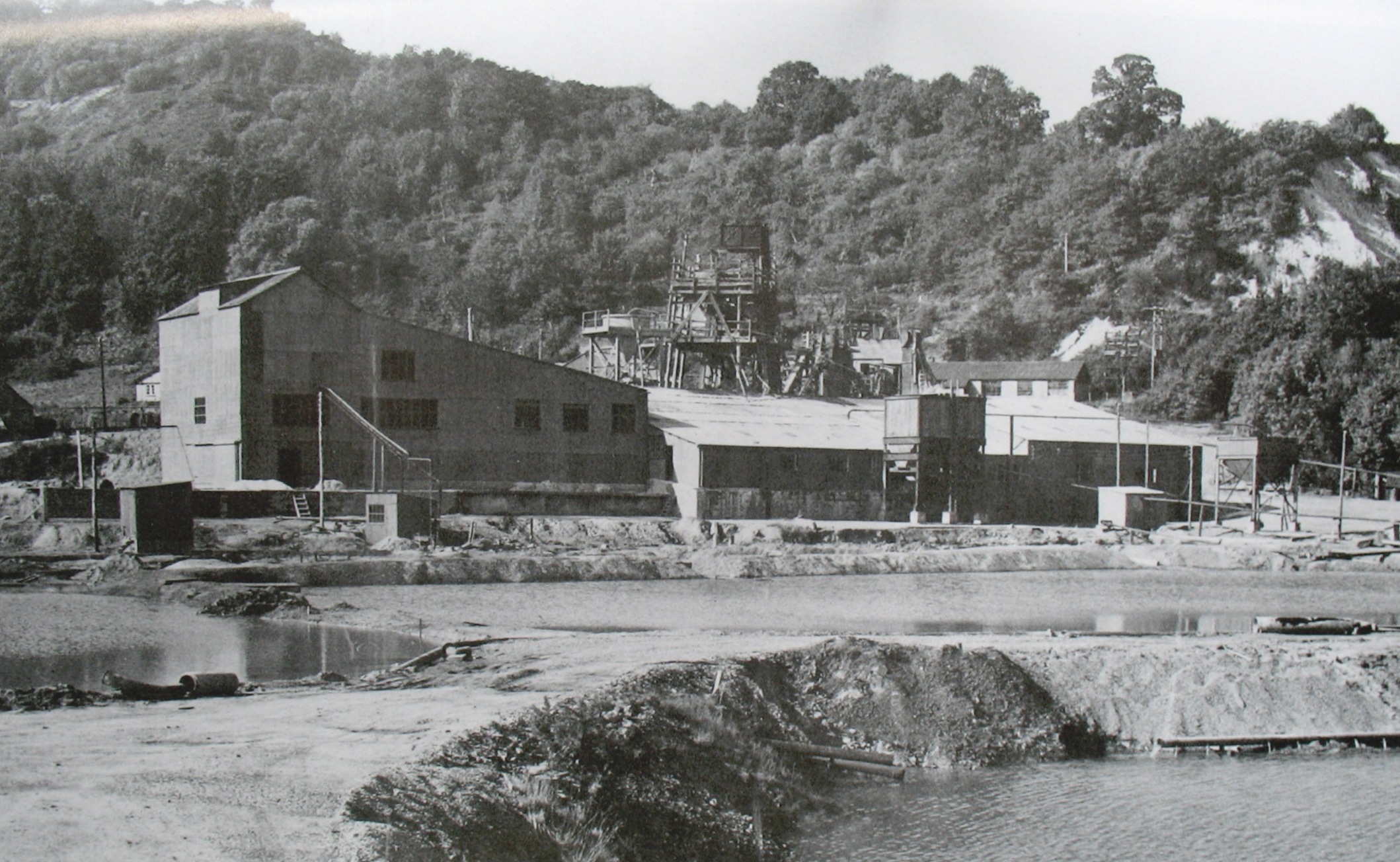 The Bridford Barytes Mine in around 1950 – one of the last deep mines in operation in the valley, only closing in 1958. It originally had its own branch line, nearly a mile in length, linked to the sidings at Christow station. (Unlike the other minerals mined in the Teign valley, barytes is not encountered in everyday life, so one might be curious about its properties and uses. Apparently it is a heavy, brownish mineral that is relatively inert both chemically and physically, and has good sound deadening, fire retardation, and radiation-shielding properties. It has been used to make barium carbonate, used in highly finished glass; barium sulphate, a paint component and a filler for paper making; and other compounds used as additives to lubricating oils. These days its main application is as a weighting agent for drilling fluids in oil and gas exploration, to suppress high formation pressures and prevent blowouts – and like much else, most of it comes from China.)
The Bridford Barytes Mine in around 1950 – one of the last deep mines in operation in the valley, only closing in 1958. It originally had its own branch line, nearly a mile in length, linked to the sidings at Christow station. (Unlike the other minerals mined in the Teign valley, barytes is not encountered in everyday life, so one might be curious about its properties and uses. Apparently it is a heavy, brownish mineral that is relatively inert both chemically and physically, and has good sound deadening, fire retardation, and radiation-shielding properties. It has been used to make barium carbonate, used in highly finished glass; barium sulphate, a paint component and a filler for paper making; and other compounds used as additives to lubricating oils. These days its main application is as a weighting agent for drilling fluids in oil and gas exploration, to suppress high formation pressures and prevent blowouts – and like much else, most of it comes from China.)
Chudleigh station in 1958 (c) Peter Gray
During the war petrol was rationed and rural buses were scarce, so passenger traffic increased, only to fall away again by the early 1950s. The TVR eventually closed for passenger traffic in 1958. There is a short (1m20s) BBC film clip taken on the last day of passenger services, which is available at http://news.bbc.co.uk/local/devon/hi/people_and_places/history/newsid_8370000/8370729.stm . Freight traffic, mainly for stone, continued for some years after that, but by 1966 had largely gone over to road transport, and in 1968 Devon County Council exerted pressure to have the line closed so that the trackbed could be used for a new A38 Chudleigh by-pass. The track was removed and road construction started in 1969, and the new road opened in 1973.
It’s interesting to see what evidence there is of its existence 40 or 50 years after the closure of the railway along the Teign valley. The occasional special train runs along the track that still exists from Newton Abbott to Heathfield – the one that ran on November 27th 2011 reportedly being the first to let passengers off at Heathfield since the line closed over 50 years earlier.
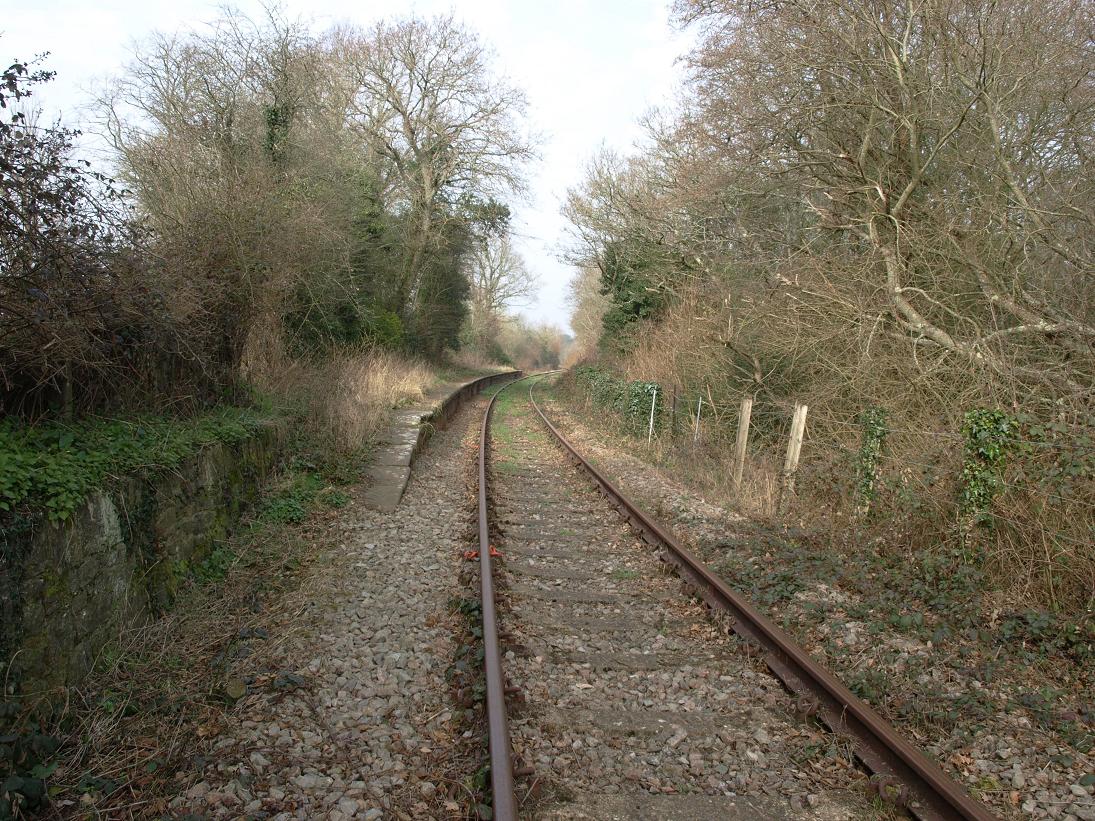 The Newton Abbot to Heathfield track at Teigngrace, with the remains of the platform of Teigngrace Halt (March 2012)
The Newton Abbot to Heathfield track at Teigngrace, with the remains of the platform of Teigngrace Halt (March 2012)
This track also serves the freight siding near Teign Bridge, and in November 2011 it was announced that a weekly freight train with 600 tones of timber collected from across Devon and Cornwall will run from there to a factory in North Wales that makes laminate flooring and wooden panels. The freight company chose the siding because of ease of access – it was empty and not situated in a town.
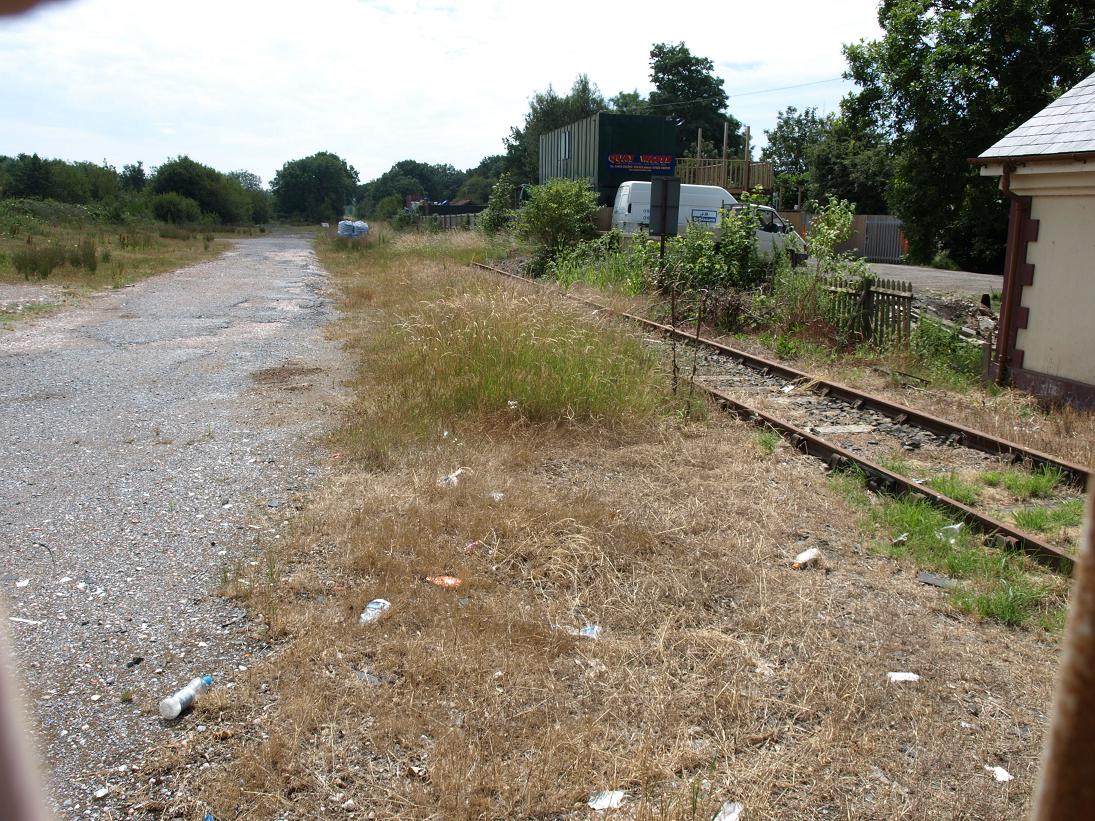 The disused line at Teign Bridge (July 2009)
The disused line at Teign Bridge (July 2009)
… and back in use for the transport of timber (March 2012)
The station buildings at Christow are still there and the goods yard is the site of an embryonic reclamation project run by a dedicated railwayman called Chris Burges, who is also a campaigner for an integrated public transport system – see www.teignrail.com It is good to see that Devon County Council’s strategy for the middle Teign valley includes the protection of the route of the disused railway ‘for potential reopening or recreational use’.
In some places it is possible to see the line of the track – visible in the photo below on a path from Crocombe Bridge to Crockham railway bridge.
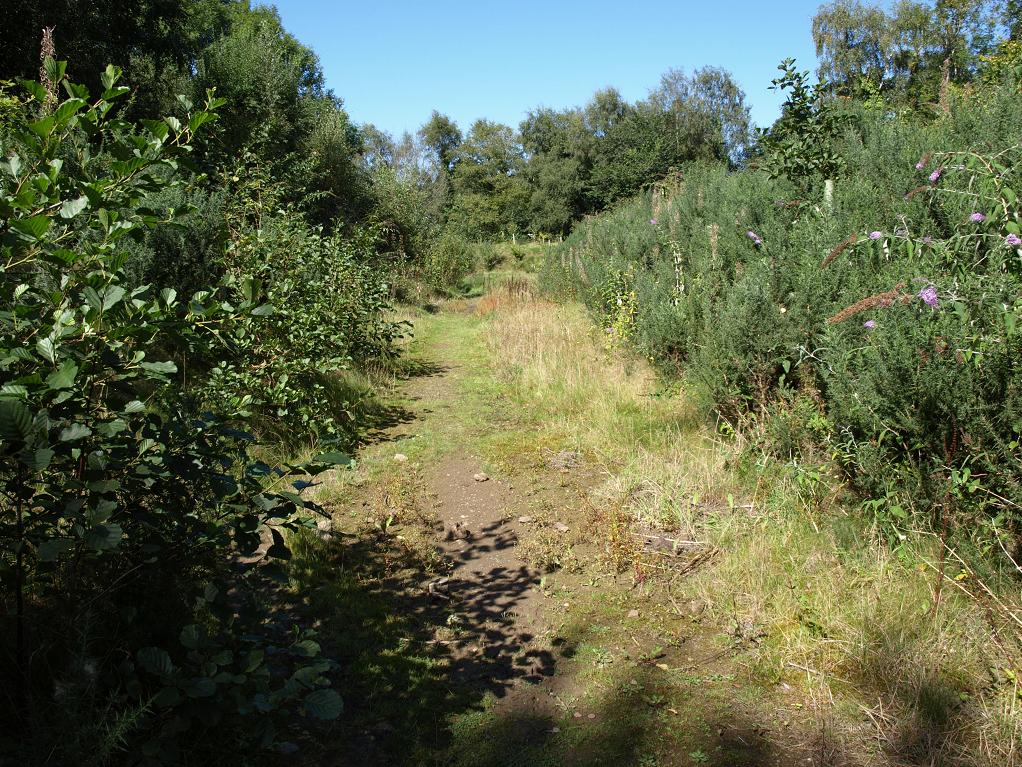 The line of the track just south of Crocombe Bridge (September 2009)
The line of the track just south of Crocombe Bridge (September 2009)
The Crockham railway bridge over the Teign is also still there, though almost totally overgrown.
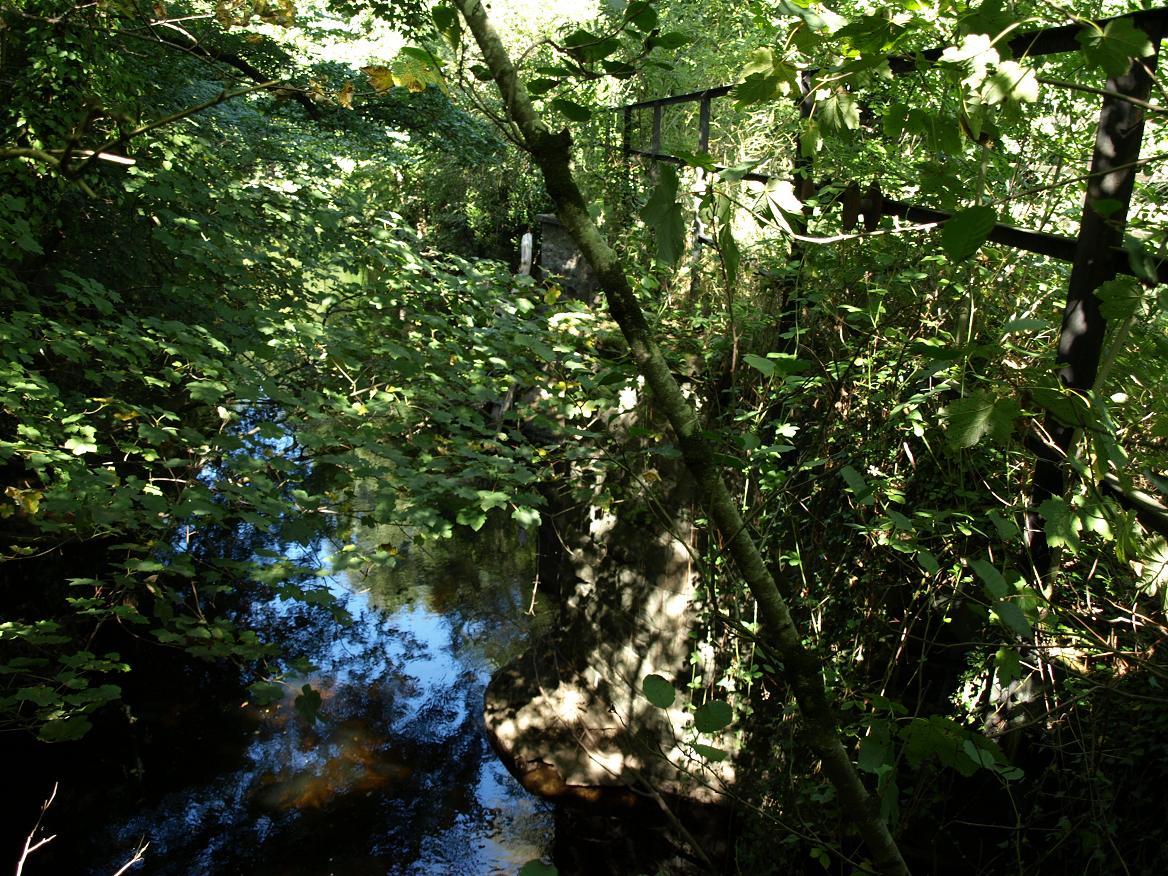 Crockham railway bridge (September 2009). At first sight this photo is just a muddle. The railing of the bridge starts top right and recedes from view into vegetation. The blue patch is the river, flowing under the bridge. One of the bridge pillars can be seen in the centre, partly obscured by vegetation and shadows.
Crockham railway bridge (September 2009). At first sight this photo is just a muddle. The railing of the bridge starts top right and recedes from view into vegetation. The blue patch is the river, flowing under the bridge. One of the bridge pillars can be seen in the centre, partly obscured by vegetation and shadows.
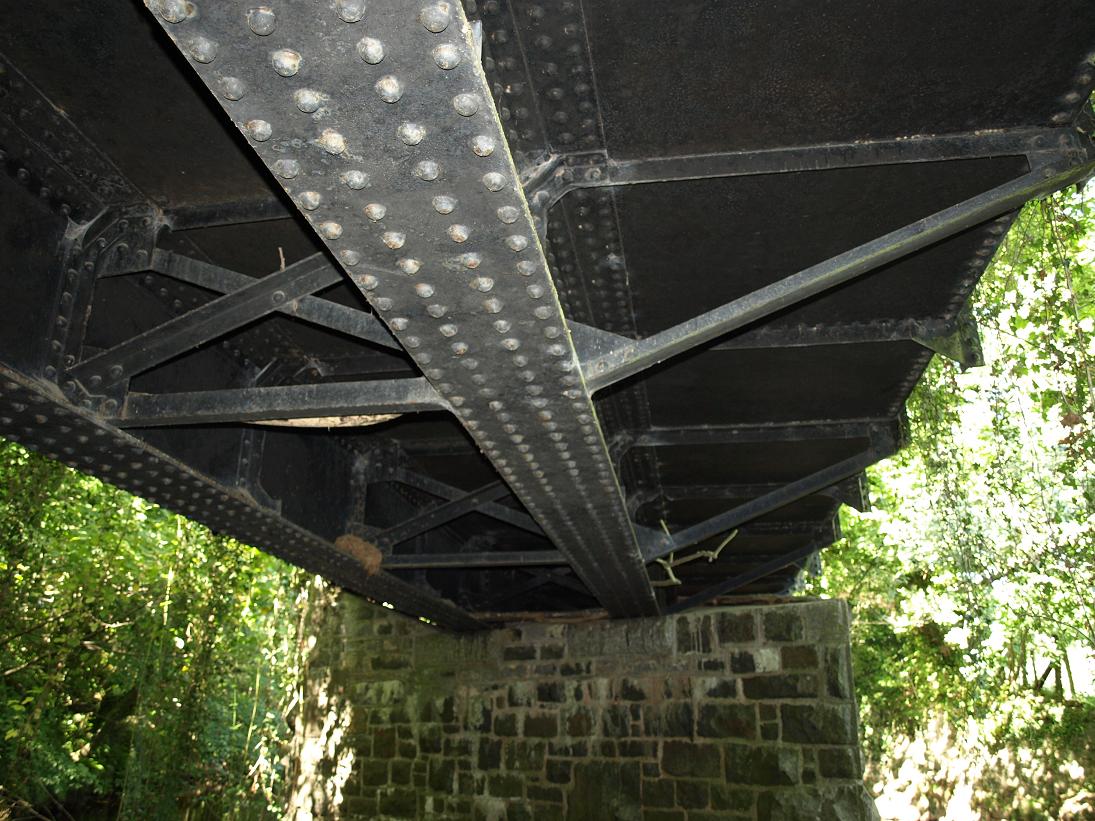 Underneath the Crockham railway bridge (September 2009). No rust or damage is apparent. In spite of being nearly buried by vegetation, this bridge looks in surprisingly good shape.
Underneath the Crockham railway bridge (September 2009). No rust or damage is apparent. In spite of being nearly buried by vegetation, this bridge looks in surprisingly good shape.
